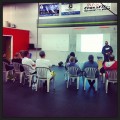
I am stealing this concept from a recent interview that I watched featuring Tim Ferriss , and professional photographer Chris Jarvis . The context of the positive constraint idea in their discussion was surrounding how to take excellent pictures, and both Tim and Chris agreed that often the best photographs don’t come from high end fancy cameras and gear (don’t get me wrong, they’re great if you know, how to use them) but rather from simple cameras and excellent composition . In other words, you can’t buy your way to great pictures, you actually have to take good pictures. Often, when you are forced into working wiihn constraints, your pictures improve, because you rely on good subjects and good picture composition rather than the fancy features of your $3000 set-up.
You may be asking yourself how this applies to CrossFit?
Movement in general is very much framed by many positive constraints:
Gravity.
Economy of movement (i.e. technique).
Injury and inflexibility.
Body dimensions.
Time and space.
Fear.
You goal as the mover is to take these positive constraints and learn to work within them.
If you were to pick one word to describe anyone who society regards as being an amazing mover, or top athlete, what would it be?
Might I suggest the word: Effortless
How is it that the best movers (usually those winning at their respective sports) make it look the easiest? You would think that they are the are the ones trying the hardest…, but I would argue that these people, whether they know it or not, have found the sweet spot in their positive constraints. They have struck a balance between the forces of nature that are given to us for free (gravity, muscle elasticity, ground reaction etc.) and technique, or more specifically, the body positions that allow these forces to act on us most efficiently. Said another way, these movers are much closer to their ideal form than the rest of us, and thus have to work less due to their high movement efficiency.
While what constitutes “ideal form” is hotly debated within specific sports, there is a general consensus however that every human individually has one best way to perform any movement. Think back on your own experiences and you can probably identify a few situations while watching an amazing mover that just made you stop and think WOW. Humans have this innate ability to recognize high quality movement. Studies have shown that we evaluate things like attractiveness and compatible genes by how well a prospective partner moves.
Take the two video below for example.
Knowing nothing about their passed history, or whether they’ve had professional training, one just “looks” better than the other. In terms of athletic endeavors, the better your movement looks, typically the closer you are to your ideal form. Keep in mind that perfect form is a journey with no real end point. Ideal form is what we are always striving to achieve, but we will never actually attain. We will always be bound by constantly changing positive constraints.
Your job as the mover is to apply the best technique you can within the constraints given to you.
To reiterate, your progression as a athlete should follow this very structured path: Technique>Consistency>Intensity
Focus on your movement and things like speed, power, and strength are just a matter of time.
Photo credit: John Lemieux





.gif)











